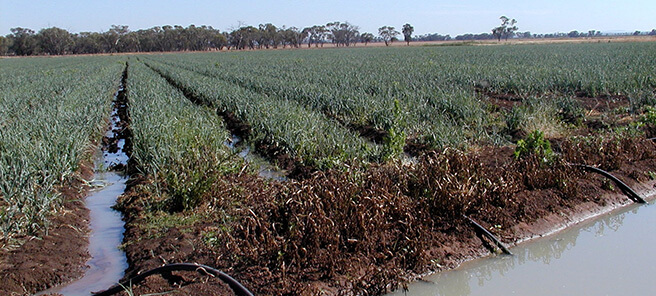Good irrigation system design and maintenance has the potential to both lift productivity and reduce energy costs.
Distribution uniformity (DU) is a measure of how evenly an irrigation system applies water. Low DU means that some parts of the crop are too wet while others are under-watered. Many growers compensate by irrigating to satisfy the driest area of the crop. This extends irrigation run times, increasing power consumption.
In WA the additional power used to overcome poor DU was estimated to increase power consumption by 700 KWh/ha per year across 16 vegetable growers, with the worst irrigation system adding 2,000 KWh/ha annually to the power bill of one grower.
Energy costs can also be reduced by making sure the irrigation system is running at the designed pressure and flow rate, or changing the system to reduce the required pressure.
Of the 16 vegetable properties in WA, 9 had acceptable irrigation systems. the other 7 had problems due to incorrect pipe sizes or lack of adjustment for slope. These problems were compensated for by increasing the pumping pressure and, therefore, the energy required to apply the same amount of water.
Improving DU ensures the entire crop receives the right amount of water, lifting total productivity as well as reducing power consumption. Solid set and traveller irrigation systems for cauliflower, lettuce and sweet corn have all been found to have distribution uniformity of only around 70%. Increasing DU to 90% or more can increase yield by 7 – 13%.
Energy use varies greatly between systems. For example, while furrow irrigation may require only 45 KWh / ML, a high pressure traveller may require 543 KWh / ML. In the Tasmanian example shown below, energy savings of 66% and a total cost saving of $47.12 / ML can be obtained by changing from a high pressure travelling gun to a low pressure centre pivot.
| Travelling gun | Centre pivot | |
| Hydraulics (m) | ||
| End pressure | 52 | 14 |
| Friction loss in irrigator or hose | 28 | 0.7 |
| Hose - mainline | 4.1 | 2.8 |
| – sundry | 7 | 7 |
| Static head | 7 | 7 |
| Total head | 106.1 | 39.5 |
| Pump | ||
| Pump duty | 17.1 l/s @ 106.1m | 18.5 l/s @ 39.5m |
| Pump efficiency | 66% | 81% |
| Motor efficiency | 92% | 92% |
| Costs | ||
| Cost per hour - off peak | $3.22 | $1.06 |
| – peak | $7.33 | $2.41 |
| Run time (hours per day) | 15 | 15 |
| Total KWh / day | 443 | 146 |
| Cost per day | $64.77 | $21.27 |
| Cost per ML | $70.16 | $23.04 |
However, the biggest advantage in changing irrigation systems may be improved crop management with resulting increases in yield and quality. For example, replacement of a travelling gun with a centre pivot in a NSW farm provided an energy saving of around $50/ha. But the bigger benefit was a 20% increase in yield and improved product quality. Combined, these resulted in a net benefit of $565/ha.
Scott Barber & Steven R. Raine 2002. Using commercial distribution uniformity and yield data to improve irrigation management. International Water & Irrigation, 22,17-22.
